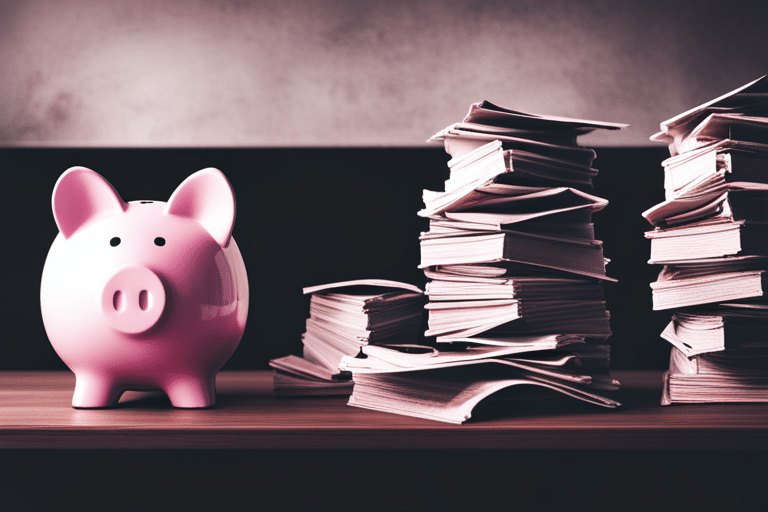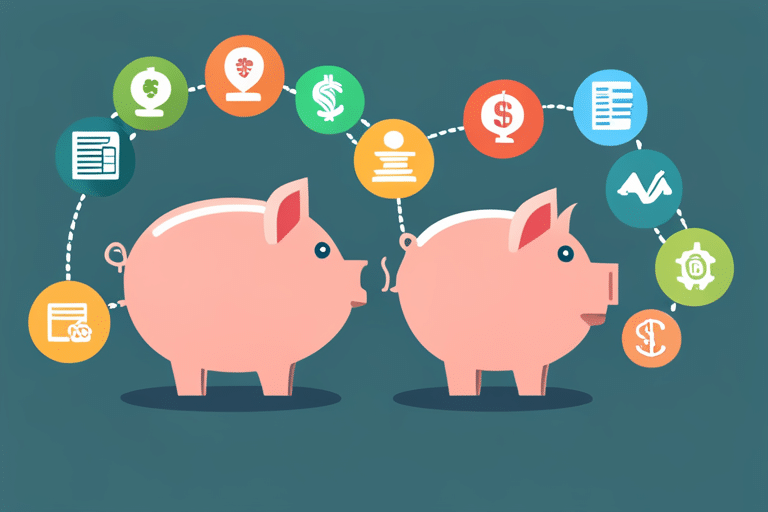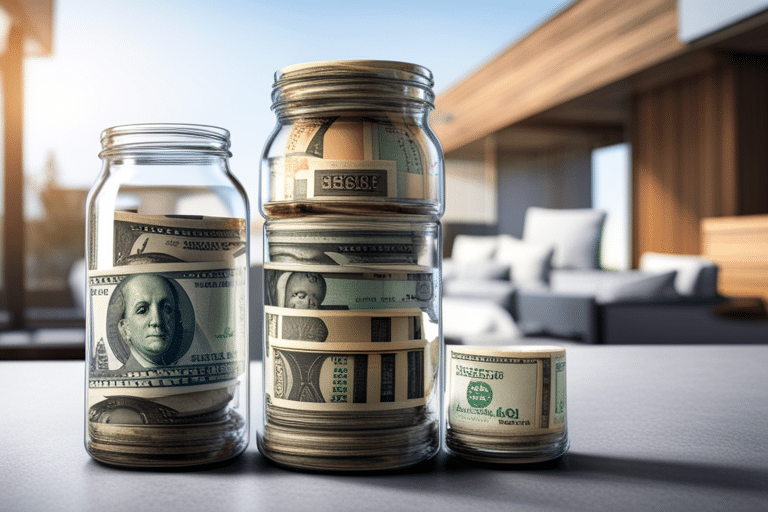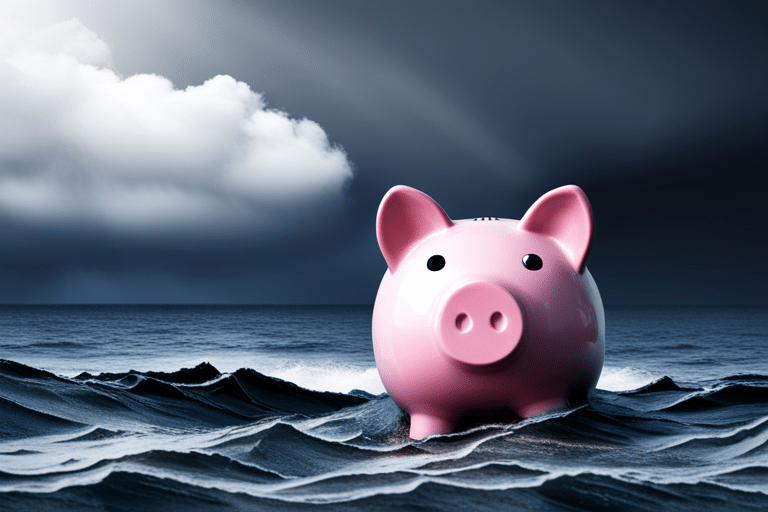Hey, you! Are you tired of feeling like a financial tightrope walker, constantly juggling debt and living expenses? Well, have no fear because the unsung hero of effective debt management is here: emergency funds!
Yes, those magical little pots of money that can save your bacon when life throws unexpected curveballs your way. In this article, we’ll dive into the importance of these funds, how to build them up from scratch, and why they’re crucial in finding balance between paying off debt and staying financially secure.
So grab a cuppa and let’s get started on your journey to financial mastery!
Key Takeaways
- Emergency funds provide financial stability and peace of mind during unexpected situations.
- Building an emergency fund involves starting small and gradually increasing savings over time.
- Consistency is key in building an emergency fund, treating it as a game or challenge can help.
- Consider investment options and risk management, diversifying investments and ensuring funds are easily accessible when needed.
The Importance of Emergency Funds

Having an emergency fund is crucial in ensuring financial stability during unexpected situations. It’s like having a superhero cape tucked away in your closet, ready to save the day when life throws you a curveball. Building an emergency fund may sound as exciting as watching paint dry, but trust me, it’s worth it.
Picture this: you’re strolling through the park on a sunny day, enjoying the blissful melodies of chirping birds, when suddenly… BAM! You slip on a banana peel and sprain your ankle. Ouch! Without that emergency fund, you’d be left hobbling around with empty pockets. But thanks to your foresight and dedication to building that safety net, you can confidently pay for medical expenses without breaking a sweat.
But wait, there’s more! Having an emergency fund not only saves you from unexpected mishaps but also provides peace of mind. No more sleepless nights worrying about how you’ll handle unforeseen car repairs or surprise vet bills. With your handy-dandy emergency fund by your side, these challenges become mere bumps in the road.
Building an Emergency Fund: Where to Start

So you’ve finally realized the importance of having an emergency fund, huh? Smart move, my friend!
Now let’s talk about some saving strategies to help you build that cushion for those unexpected curveballs life likes to throw at us.
And hey, once you’ve got that money saved up, we’ll also discuss where exactly you should allocate those funds to make sure they’re easily accessible when you need them most.
Exciting stuff, right? Let’s dive in!
Importance of Emergency Funds
If you don’t already have an emergency fund, it’s crucial to start building one as soon as possible. Trust me, you’ll thank yourself later when life throws a curveball your way.
Emergency funds are like secret superheroes, always ready to swoop in and save the day when unexpected expenses pop up out of nowhere.
So why exactly are emergency funds so important? Well, for starters, they provide a safety net during tough times. Whether it’s a medical emergency or a car breakdown, having that cushion of cash can prevent you from drowning in debt or resorting to credit cards. Plus, knowing you have money set aside gives you peace of mind and helps reduce financial stress.
Now let’s talk strategy. Building an emergency fund doesn’t have to be overwhelming. Start small by setting aside a percentage of your income each month and gradually increase it over time. Automate your savings so that money magically disappears into your emergency fund before you even realize it.
Saving Strategies for Emergencies
Let’s start small and gradually increase the amount we set aside each month to build our emergency fund. Think of it as a game – a fun challenge to conquer.
The key is consistency, my friend. Like squirrels stashing acorns for the winter, we too can build our financial security by diligently saving for unexpected expenses.
Start with just a few dollars every paycheck and watch your emergency fund grow. As you gain confidence and see the benefits of having this cushion, increase your contributions bit by bit. It’s like building wealth one dollar at a time!
But don’t worry, you’re not in this alone! There are plenty of resources available to help us master the art of saving for emergencies. From budgeting apps that automatically allocate funds to online forums where money-savvy individuals share their strategies – there’s something for everyone.
Where to Allocate Funds
Once you have established your emergency fund, it’s important to consider where to allocate your funds next. Congratulations on being a financial superhero! Now, let’s talk about how to make those hard-earned dollars work for you.
It’s time to explore the world of investment options and risk management. Don’t worry, we’re not asking you to become a Wall Street expert overnight. We just want you to dip your toe in the water and see what suits your fancy.
Maybe stocks are your thing, or perhaps real estate tickles your fancy. Whatever it may be, remember that every investment carries some level of risk. But fear not! With proper research and guidance, you can navigate these waters like a pro.
How Emergency Funds Can Help Manage Debt

Having an emergency fund can greatly assist you in effectively managing your debt. Think of it as the superhero cape that swoops in to save the day when unexpected expenses come knocking at your door.
Picture this: you’re sitting on a pile of debt, feeling overwhelmed and stressed. Suddenly, out of nowhere, your emergency fund emerges like a shining knight in armor, ready to tackle those unexpected expenses head-on.
Financial stability is crucial when it comes to managing debt, and having an emergency fund can provide just that. It acts as a safety net, protecting you from falling into deeper debt when life throws unexpected curveballs your way. Whether it’s a broken-down car or a sudden medical expense, having those funds set aside gives you peace of mind knowing that you have something to rely on.
So how exactly do you use these magical funds? Well, let’s say your car decides to go kaput and needs some serious TLC. Instead of panicking and resorting to putting more charges on your credit card or taking out another loan, you can dip into your emergency fund for the necessary repairs. This not only helps keep your debt under control but also prevents any further financial strain.
Strategies for Saving and Growing Your Emergency Fund

So, you’ve recognized the value of having an emergency fund to help manage your debt. Well done, my savvy friend! Now it’s time to dive into some strategies for saving and growing that precious emergency fund of yours.
First things first, let’s talk about allocation. It’s important to determine how much money you should set aside for emergencies. A good rule of thumb is to aim for three to six months’ worth of living expenses. Take a look at your budget and see what you can comfortably save each month towards this goal.
Now that you know how much to save, let’s discuss maintenance. Treat your emergency fund like a delicate flower. Nurture it by regularly contributing additional funds whenever possible. Consider automating your savings so that a portion of your paycheck goes directly into the emergency fund without you even lifting a finger.
But wait, there’s more! Don’t just let your emergency fund sit there gathering dust. Explore ways to grow it over time. Look into high-yield savings accounts or short-term investments with low risk.
Emergency Funds Vs. Debt Repayment: Finding the Balance

To find the balance between building your emergency fund and repaying debt, it’s important to create a budget that allows for both savings and debt payments.
Picture this: you’re walking on a tightrope, trying to juggle a stack of bills in one hand and a safety net in the other. It’s not an easy task, but with some clever budgeting, you can make it work.
Let’s start with the emergency fund vs. debt consolidation debate. While consolidating your debts may seem like a tempting option to free up some cash flow, don’t forget about the importance of having a rainy day fund. Your emergency fund is like that trusty sidekick who swoops in when unexpected expenses come knocking at your door.
Now, let’s talk about the showdown between emergency funds and retirement savings. It might feel like choosing between two beloved pets, but fear not! You can give them both some love without neglecting either one. Consider allocating a portion of your income towards each goal every month—think of it as feeding two birds with one scone!
Tips for Maintaining and Replenishing Your Emergency Fund

Maintaining and replenishing your emergency fund is crucial for financial stability, as it provides a safety net for unexpected expenses. Life has a way of throwing curveballs at us when we least expect it – from car repairs to medical bills, emergencies can leave you feeling like you’re drowning in a sea of debt. But fear not! With a little creativity and determination, you can rebuild your emergency fund and regain control over your finances.
First things first: let’s talk about alternatives to the traditional emergency fund. While having cash set aside is ideal, there are other ways to handle unexpected expenses. Consider opening a line of credit or using a low-interest credit card as temporary solutions. Just remember to pay off the balance as soon as possible to avoid high interest charges.
Now let’s get down to business – rebuilding after emergencies. Start by setting realistic goals for yourself. Instead of trying to replenish your emergency fund all at once, break it down into manageable chunks. Set aside a certain amount each month and stick to it religiously.
Get creative with saving money too! Cut back on unnecessary expenses like eating out or buying that third pair of shoes (you know you don’t need them). Look for ways to save on everyday necessities – try couponing or shopping sales.
Frequently Asked Questions
How Much Money Should I Have in My Emergency Fund?
You should have enough money in your emergency fund to cover unexpected expenses like a flat tire or a broken phone. Follow emergency fund savings strategies and determine an appropriate amount for peace of mind.
Can I Use My Emergency Fund to Pay off My Credit Card Debt?
You’ve got that emergency fund, that unsung hero in your financial arsenal. But should you use it to pay off credit card debt? Let’s weigh the alternatives and explore the pros and cons.
What Are Some Ways to Save and Grow My Emergency Fund?
Looking for ways to save and grow your emergency fund? Try out some investment strategies or explore alternative options. There are plenty of creative ways to build up that safety net!
Should I Contribute to My Emergency Fund Even if I Still Have Outstanding Debt?
Should you contribute to your emergency fund while still in debt? Absolutely! Having an emergency fund brings peace of mind and helps you avoid going further into debt. Prioritize contributions by setting aside a small amount each month.
How Often Should I Review and Adjust My Emergency Fund Savings Goal?
You’re doing great with your emergency fund! Now let’s talk about how often you should review and adjust your savings goal. Stay on top of it, maybe every six months? Keep that target in sight!
Conclusion
Congratulations! You’ve reached the end of this whimsical journey through the world of emergency funds.
Now, here’s a fascinating statistic to leave you feeling inspired: Did you know that having just $500 in an emergency fund can prevent 80% of financial disasters? Yes, it’s true! So, don’t underestimate the power of that little cushion.
Start building your emergency fund today and let it be your unsung hero in effective debt management. Remember, with a bit of commitment and creativity, you can conquer any financial challenge that comes your way.
Happy saving!

